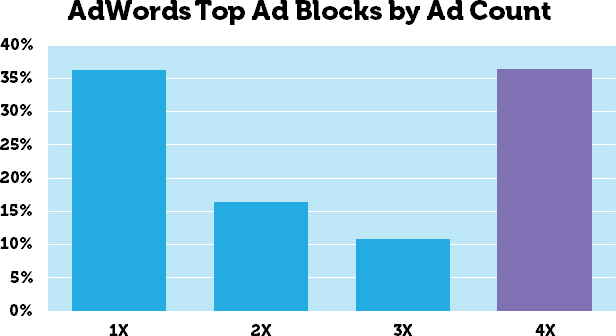If there’s a key to success in the ever-changing world of search engine marketing, it’s the ability to be resilient. This idea is particularly relevant in light of Google’s latest update. For those of you who haven’t noticed, Google has revised its search engine results pages (SERPs) in a way that affects both paid and organic efforts. Here’s everything you need to know about the latest update, and the best ways to come out on top.
The Update

In February, Google updated its search engine results pages so that there are no longer any paid search ads on the right-hand side, and there are now up to 4 paid ad blocks instead of 3 at the top of each page. The elimination of the side ads, which used to allow room for up to 8 spots, is likely in an effort to maintain mobile consistency, as mobile devices did not support the right-hand column. Google has been pushing for a mobile first design for quite some time now as the majority of worldwide searches are taking place on phones and tablets rather than on desktop.
With more real estate on SERPs being taken up by paid ads, organic search seems to be getting the raw end of the deal. When you take into account local searches, organic search results are often getting pushed below the visible fold of the page. While this all may sound alarming for SEO, there’s no need to panic. At this point, two thirds of SERPs haven’t adapted this format. Even for the pages that do have four ads on top, there are still plenty of ways to stay successful in organic, paid, and local SEM efforts.
1. Organic Search Results
While many might think that this change means they should shift all of their efforts to paid search and abandon SEO, this is not at all the case. Now more than ever websites need to focus on their SEO efforts, as more value is being placed within the first few organic slots that manage to make it on the upper fold of SERPs.
Even with this dramatic change to search engine result pages, there is still a trust factor that consumers seem to value in organic verses paid results. With 51% of B2B and B2C traffic coming from organic and only 10% coming from paid search ads, search is clearly still a force to be taken seriously.
2. Paid Search Ad Positions
Now that the right hand ads are being pushed to the bottom of the page and onto the 2nd page, spots 5-11 are already seeing a decline in click through rates. Therefore, similar to organic results, more emphasis should be placed on ranking in the top spots of paid search ads. Overall, it seems that your site’s highly commercial pages should have a paid search strategy, while your information-based pages should focus on SEO.
3. Local Search Results
Often times, local search results are what lay between paid and organic search spots. Therefore, if someone is making a search in the vicinity of you business’ product or service, you want to be in that pack of locations. First and foremost, you must set up a Google My Business, verify your business, and optimize the content so that you will show up for all relevant, local keyword searches. It’s also important to have your business’ address on every page of your website, and mention the city of your business throughout site content, Meta titles, and Meta descriptions.
This update is still relatively new, and will continue to evolve. The best thing to do is to continue to pay attention to Google updates and make strategic changes to your search engine marketing strategy. At Starkmedia, we stay up to date on all of the emerging trends in SEM and apply this knowledge to our client’s existing marketing strategies. Contact Starkmedia today to learn more.